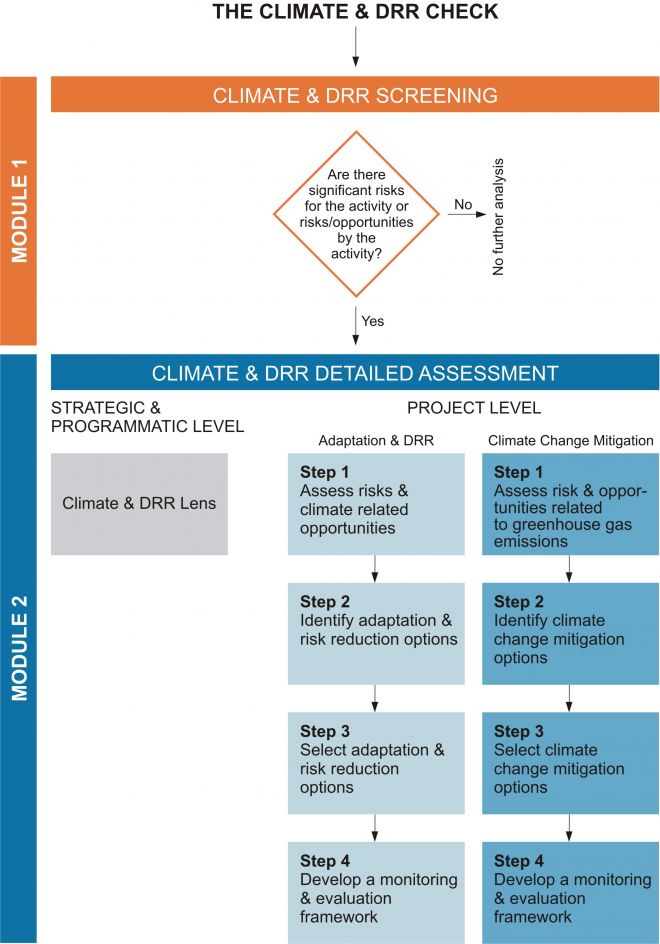The image below illustrates how Module 1 and Module 2 fit together:

Module 1 - Climate and DRR Screening
What is the purpose of Module 1?
This first module serves as a first screening to see whether a strategy, policy, programme or project is potentially at risk from climate or natural disasters and whether a greenhouse gas emission reduction potential exists. It helps to make a rapid and rough assessment of risks and/or opportunities and to take a decision whether to proceed with a detailed assessment (Module 2). In general, it is recommended to opt for a detailed assessment if there are significant risks and low capacities for coping with these risks.
How long does it take to complete?
Modul 1 the Climate and DRR Screening should not take more than one to two hours to complete.
How does it work?
The Climate and DRR Screening has two components: (A) Adaptation & DRR Screening (B) Climate Change Mitigation ScreeningKey questions in the provided screening check list shall be answered.
When should it be conducted?
The screening is applied at the beginning of the planning process of a new intervention (strategy, programme or project) or a new phase of a running intervention.
Who should conduct it?
It will best be conducted by the national programme officer being in charge of the intervention as he or she is familiar with the context and the focus of the intervention.
Integration:
Main conclusions should be reflected in the entry proposal (for new interventions) or review (for running intervention) and serve as an input for the mandatory risk assessment.
Module 2 – DRR Detailed Assessment
What is the purpose of Module 2?
This module allows for systematically integrating climate change (adaptation and mitigation) and disaster risk reduction into the existing or planned strategy, programme or project. It is only applied when possible significant risks and opportunities have been identified under Module 1: At the strategic and programmatic level, Module 2 is called Climate and DRR Lens and is more generic than the detailed assessment at project level.
How long does it take to complete?
The DRR Detailed Assessment should take about two to three days to complete.
Module 2 at the strategic and programmatic level (“Climate and DRR Lens”)
How does it work?
The Climate and DRR Lens is a more in depth assessment of risks related to climate change and natural disasters. The context of climate change and DRR in the strategy area is analysed and it is estimated to what extent the proposed goals/objectives could be affected by climate change and disaster risk. If the strategy faces risks from climate change and natural disasters which have not been considered yet, the strategy needs to be adjusted.
When should it be conducted?
The Climate and DRR Lens shall be applied as early as possible in the planning of a new strategy or programme of phase or a new phase of an existing strategy and programme.
Who should conduct it?
The responsible persons at the COOF and the team developing a strategy are jointly responsible for conducting the Climate and DRR Lens. Decision on an eventual adjustment of the strategy shall be taken jointly by the COOF at the headquarters or during the planning workshop.
Integration:
The findings shall be integrated into the strategy (risk assessment part).
Module 2 at the project level
How does it work?
The Detailed Assessment at project level comprises of a four step approach allowing a more in depth analysis of risks as well as the identification of appropriate adaptation / DRR and climate change mitigation measures.
Step 1:
Assess risks and climate related opportunities: Most relevant hazards, assets at risk, vulnerabilities as well as impacts of hazards are identified. A general and qualitative assessment of these risks and opportunities is conducted.
Step 2:
Identify adaptation/risk reduction or climate change mitigation options: Possible adaptation, risk reduction or climate change mitigation options are brainstormed, regardless of their feasibility.
Step 3:
Select adaptation/risk reduction or climate change mitigation options: The identified options are assessed according to criteria such as effectiveness, cost, feasibility and sustainability and the most appropriate are selected.
Step 4:
Develop a monitoring and evaluation framework: Output and outcome indicators are defined in order to monitor and evaluate the success of the options.
When should it be conducted?
It shall be conducted at the moment of the elaboration of the project document and the credit proposal.
Who should conduct it?
Responsibility for conducting the assessment is with the programme officer and the project team in charge of the implementation of the project. The approach shall be conducted in a participatory process.
Integration:
The principle entry points for integration of the results of Module 2 are the planning documents (project document, credit proposal, logframe).
